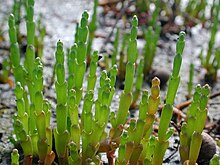
Amaranthaceae is a family of flowering plants commonly known as the amaranth family, in reference to its type genus Amaranthus. It includes the former goosefoot family Chenopodiaceae and contains about 165 genera and 2,040 species, making it the most species-rich lineage within its parent order, Caryophyllales.

Salicornia is a genus of succulent, halophytic flowering plants in the family Amaranthaceae that grow in salt marshes, on beaches, and among mangroves. Salicornia species are native to North America, Europe, central Asia, and southern Africa. Common names for the genus include glasswort, pickleweed, picklegrass, and marsh samphire; these common names are also used for some species not in Salicornia. To French speakers in Atlantic Canada, they are known colloquially as tétines de souris. The main European species is often eaten, called marsh samphire in Britain, and the main North American species is occasionally sold in grocery stores or appears on restaurant menus as sea beans, samphire greens or sea asparagus.
Sarcocornia is a formerly recognized genus of flowering plants in the amaranth family, Amaranthaceae. Species are known commonly as samphires, glassworts, or saltworts. Molecular phylogenetic studies have shown that when separated from Salicornia, the genus is paraphyletic, since Salicornia is embedded within it, and Sarcocornia has now been merged into a more broadly circumscribed Salicornia. When separated from Salicornia, the genus has a cosmopolitan distribution, and is most diverse in the Cape Floristic Region of South Africa.

Atriplex is a plant genus of about 250 species, known by the common names of saltbush and orache. It belongs to the subfamily Chenopodioideae of the family Amaranthaceae s.l.. The genus is quite variable and widely distributed. It includes many desert and seashore plants and halophytes, as well as plants of moist environments. The generic name originated in Latin and was applied by Pliny the Elder to the edible oraches. The name saltbush derives from the fact that the plants retain salt in their leaves; they are able to grow in areas affected by soil salination.
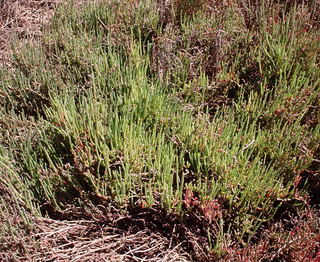
Tecticornia is a genus of succulent, salt tolerant plants largely endemic to Australia. Taxa in the genus are commonly referred to as samphires. In 2007, the genus Halosarcia, along with three other Australian genera was incorporated into the genus.

Salicornia quinqueflora, synonym Sarcocornia quinqueflora, commonly known as beaded samphire, bead weed, beaded glasswort or glasswort, is a species of succulent halophytic coastal shrub. It occurs in wetter coastal areas of Australia and New Zealand.

Camphorosmeae is a species-rich tribe of the Amaranthaceae, formerly Chenopodiaceae, with 20 genera and about 179 species. It is classified as a single tribe of subfamily Camphorosmoideae.

The Polycnemoideae are a small subfamily of plants in the family Amaranthaceae, representing a basal evolutionary lineage. The few relictual species are distributed in Eurasia and North Africa, North America, and Australia.

Tecticornia indica is a species of plant that is succulent and halophyte which grows in salt marshes on tropical areas of the world. This plant belongs to the Chenopodiaceae, which are now included in family Amaranthaceae.

Salicornia europaea, known as marsh samphire, common glasswort or just glasswort, is a halophytic annual dicot flowering plant. Other common names include pickle weed, saltwort, and chicken toe. It is a succulent plant with high water content, accounting for its slightly translucent look. It is found near saline water in Europe and is edible both raw and cooked.
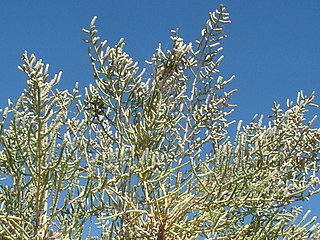
Halostachys is a genus of flowering plants in the plant family Amaranthaceae, containing a single species, Halostachys caspica. The plants are small to medium halophytic shrubs with apparently jointed fleshy stems and scale-like leaves. They are native to western and central Asia and northern China.

Kalidium is a genus of flowering plants in the plant family Amaranthaceae. The species are shrubby halophytes distributed in Southeast Europe, Southwest Asia and Central Asia to China.

Stutzia is a plant genus in the subfamily Chenopodioideae of the family Amaranthaceae. It was described in 2010, replacing the illegitimate name Endolepis. It comprises two species, that have also been included in the genus Atriplex.

Heterostachys is a genus of flowering plants in the plant family Amaranthaceae. The two species are shrubby halophytes native to South America and Central America.
Arthrocnemum was a genus of shrubs in the family Amaranthaceae. Two or three species were included in the genus. They are halophytes with fleshy, apparently articulated plant stems and reduced leaves and flowers.
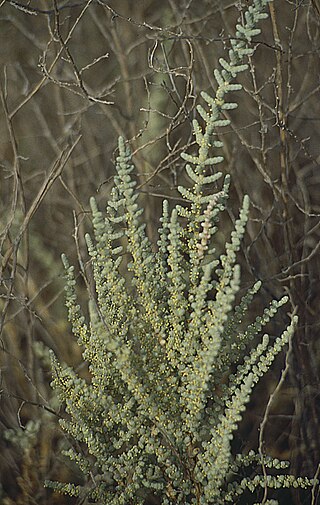
Halocnemum is a genus of halophytic shrubs in the family Amaranthaceae. The plants are fleshy and apparently articulated with characteristic globular or short-cylindrical lateral branches, and reduced leaves and flowers. There are three or two species, occurring from Southern Europe and North Africa to Asia.

Halopeplis is a genus in the family Amaranthaceae. The plants are halophytes with not articulated stems and fleshy stem-clasping leaves. There are three species, occurring from the Mediterranean basin and North Africa to Southwest Asia and Central Asia.

Microcnemum is a genus in the plant family Amaranthaceae, containing a single species, Microcnemum coralloides. It is a dwarf annual halophyte with fleshy, apparently jointed stems and reduced leaves and flowers. The two subspecies show a disjunct distribution in Spain and Western Asia.
Kelly Anne Shepherd is an Australian botanist, who has published some 91 names.
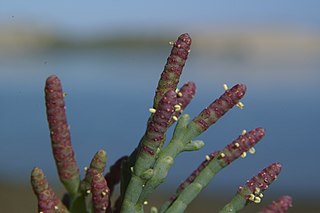
Salicornia pacifica, also known as pickleweed, sea asparagus, Pacific swampfire, or glasswort, is a species of low-growing perennial succulent halophyte in the genus Salicornia found in the Pacific coast of North America and California.
